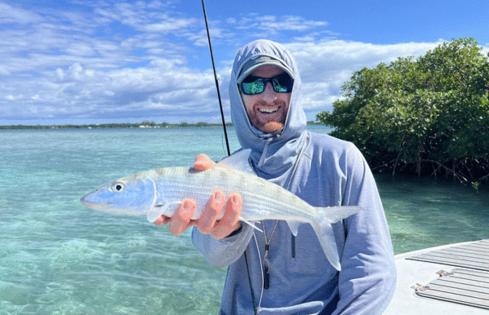Dennis Anderson: In the Bahamas, pursuing dinner can also bring hungry sharks
Published in Outdoors
SPANISH WELLS, BAHAMAS – Roy Pinder eased his sleek 25-footer from the dock and motored through the harbor here past the big boats from which he dove for lobsters for more than 30 years, living on board for up to a month at a time.
On this day in the harbor in addition to Roy's boat and the big lobster boats, a few pleasure yachts were tied up whose transoms bear the names of distant ports. Also smaller boats abound, some used by conch fishermen but most owned by sport anglers and rigged for wahoo, grouper, snapper and the like.
The wind was up and would build throughout the day. Not too much wind for Roy's boat, but by contrast the few Spanish Wells flats skiffs that cater to bone fishermen when the wind is quieter were knotted to docks.
Roy, who is 73, earns a living in his boat ferrying tourists to nearby islands. Visitors stroll on endless sand beaches or snorkel or feed squid to stingrays that swarm around the tourists' legs. Also, pigs inhabit one island and photo-snapping tourists swim with them and feed them as well.
"The swimming-with-the-pigs-thing is lost on me," said Barb Hexum.
Barb and her husband, Tom, of Rochester, Minn., were on Roy's boat as well and have been coming to Spanish Wells for decades. Not quite 2 miles long and a quarter-mile wide, Spanish Wells is reached only by boat and has no casinos, golf courses or, really, anything to do after 5 p.m. except eat, read or sleep.
"Quiet is the way people like it here," Tom said.
A Spanish Wells native, Roy has been in and on water his entire life. As a boy, he learned to free dive without air tanks or compressors because there were none. By the time he was 15 or 16 and certainly by 17 he could hold his breath and dive 70 feet, a skill that, with a speargun in his hand, or Hawaiian sling as they're called, could bring him to within shooting range of hogfish, snapper and grouper. Spearing one of these near the ocean bottom, Roy, while still holding his breath, would surface with his impaled quarry. Sometimes while ascending, blood clouds arose from the speared fish and the blood attracted sharks. If the sharks couldn't be bullied into leaving, Roy moved his boat and with his speargun dove elsewhere.
This strategy worked except when it didn't, and it didn't on June 25, 1968, when Roy was 17 and diving with a friend for grouper on a cooker of a day beneath a new moon.
Roy had speared a grouper, a big one, 40 feet down when a Caribbean reef shark, or perhaps a silky shark, attacked him head-on, its jaws quickly opening before closing around Roy's head and tearing at it and also at his face.
...continued
©2024 StarTribune. Visit startribune.com. Distributed by Tribune Content Agency, LLC.







Comments